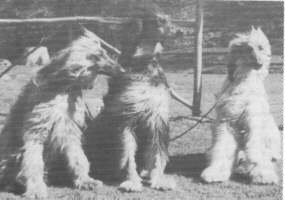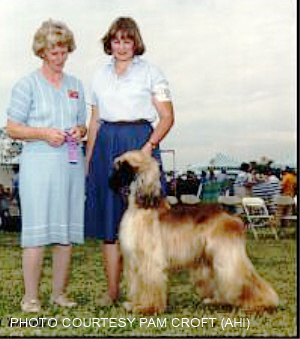(Afghan Hound Database and Breed Information Exchange)
OF ELTAZZI KENNEL,AUSTRALIA. Published in the 1990 Australian Afghan Hound Yearbook Acknowledgement. - We wish to express our sincere thanks and appreciation to Helen Furber (Furbari) for granting us permission to reproduce on these pages the interview with Barbara Skilton which was originally published in the 1990 edition of the Australian Afghan Hound Yearbook We have been honoured to have been granted this interview with Barbara Skilton. Since the 1940's she has been a dedicated owner of the Afghan Hound, and was instrumental in the breed being re established in Australia in the early 50's. As this interview will show, and as seen in the pedigrees of many of todays top winners, Afghan Hounds that Barbara originally sent, and later imported from famous English, Scottish and European Kennels, are the antecedents of the backbone of most Australian Afghan Hound. Her dedication includes her own ElTazzi Afghans - never has one heard of them being abandoned - if owners can't keep them for one reason or another, Barbara has always assumed responsibity for them. Her expertise with the restricted Afghan gene pool of the 50s and 60's is truly remarkable as from her first 40 champions, 14 achieved Best in Show awards, something I doubt could be achieved by most breeders of today. QUESTION: In which year did you first become interested in Afghan Hounds? BARBARA: It was 1945 when still living in England, I first met a full brother of Eng. Ch. Blethingley Tajomeer. My primary doggy interest at that time was in Cocker Spaniels, however, I was asked to handle this Afghan at the first Afghan Hound Assoc. Show held after World War 2. The judge was Brigadier General Lance, famous for the Sarona Salukis, but who had owned and coursed Afghans prior to the war. It was at this show that I first saw Molly Sharpe's Chaman Afghans and also met Mrs Peggy Riley of Bletchingley fame. I was impressed by many of the dogs I saw and fell in love with the movement, they floated over the ground with smooth effortless ground covering gaits
QUESTION: With which did kennel did you get your basic experience? BARBARA: I worked with Mrs Riley of Bletchingley, mainly to learn more about Cocker Spaniels, but 18 months later I left, convinced I could not live without an Afghan. Blelchingley Tajomeer had become a special favourite, sharing my room and even accompanying me on many of my days off, it was a sad parting when I left. I lived quite close to Brig. Gen Lance at that time, and we often met on the train going to and from shows. He was such an interesting man with a wealth of knowledge, and I learned a lot from him. QUESTION: To which kennel were you ultimately attracted? BARBARA: Knowing so many of them personally, naturally I was attracted to the BLETCHINGLEY hounds, they were largely based on CHAMAN, the stock which had really impressed me at that first show. I thought they were beautiful, especially INT. CH. TAJ. One old black/tan bitch I really fell in love with was TULLAH OF PUSHTIKUH an inbred daughter of CH SIRDAR OF GHAZNI. She was 13 years old when I saw her but she certainly did not look it, her movement was quite breathtaking. Maybe this is why I have favoured the MOUNTAIN type of Afghan Hound, in those days they certainly had something the others lacked -they still do if kept comparatively unadulterated. 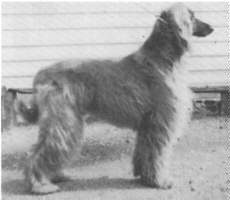 QUESTION: In which year was your first Afghan born? BARBARA: In 1944, and her name BAHBOOK OF BLETCHINGLEY she was a self masked cream/apricot whom we called 'Saidi'. She was a daughter of the small rich red, self masked Int. Ch Garrymhor Faiz-bu-Hassid X Ravelly Badrea a creamy fawn with lovely bluey mauve shadings. Her grandfather was the Afghanistan import ARDMOR ANTHONY. Basically she was a mountain type of GHAZNI breeding. FAIZ-BU-HASSID was a legend on the race-track. I only showed Saidi at smaller shows where she won a place everytime. She really made her mark more as a brood bitch and under my English prefix DEVILKIN, her children and grandchildren started to win all types of shows. One daughter DEVILKIN DATOOBHOS sired by ENG. CH BLETCHINGLEY TAJOMEER ultimately became the foundation dam of Australian Afghans post W.W.2. QUESTION: So your breeding was responsible for the resuscitation of the Afghan Hound breed in Australia after W.W.2? BARBARA: Yes. A Mrs Ward was emigrating to Australia and took with her DEVILKIN DASTI PASHA a rich red male sired by CH. NETHEROYD ALIBABA, and prevailed upon me to later send her DEVILKIN DATOOBOS after she had been mated to MESHKI BAZ-I-PUSHTIKUH. The litter was born in Australian quarantine - one of the progeny CH. GOLITHA ABDULLAH was a multiple Best In Show winner. QUESTION: Which year did you arrive in Australia and what Afghans accompanied you? BARBARA: In 1954 we arrived in Australia, bringing with us a B/T son of MESHKI BAZ-I- PUSHTIKUH called AGHAI OF HAWKFIELD. Previously, when taking DATOOBHOS to this kennel for her mating, when seeing this Meshki Baz son, I fell in love with him. QUESTION: So what kennel names does your Afghan breeding come under? BARBARA: DEVILKIN in England, then after arriving in Australia, picking up my Devilkin stock which Mrs Ward had bred under the GOLITHA prefix, I registered ELTAZZI . QUESTION: Were your early lines mountain or desert type? BARBARA: Predominately mountain type - however they all carried a small amount of desert breeding which showed through from time to time. When other breeders used my lines and selected to breed on from those showing the desert type, then of course, it became more obvious and fixed. QUESTION: Was it difficult getting the breed accepted here? BARBARA: Extremely difficult - whenever we moved into a different area the farmers would warn us they would shoot any of our dogs if they saw them in their paddocks. The Greyhound people who used to show their dogs, refused to compete against 'those hairy crossbreds', and, when I showed for the first time at the Melbourne Royal, the most frequent comment was 'How often do ya shear 'em?' We got quite a lot of publicity at that Royal because an Afghan had strayed in the Woodend area, and was being hunted by an armed posse because it was mistaken for a lion. Luckily the dog returned home before the posse caught up with it! Many judges at first, did not appreciate the coat pattern and refused Challenges because they thought the Afghans were out of coat, or recovering from some skin disease. Others penalised them for being too thin because they could see their hipbones, and so on. QUESTION: I can quite believe this. As recently as 1989, a Vet in court in Tasmania, when questioned about Afghans being lean with prominent hipbones, stated he could not 'equate the rules of show(ing) Afghan Hounds with good husbandry'. So leaving Vet's ignorance aside, what later Afghans did you import to complement your earlier lines, and why? BARBARA: Besides AGHAI OF HAWKFIELD, we had GOLITHA YASMIN (Ch DEVILKIN DASTI PASHA X DEVILKIN DATOOBHOS) - Yasmin became the first female to win B.l.S. in Australia. And later came GOLITHA SHALIMAR (AGHAI X a DEVILKIN DATOOBHOS daughter born in quarantine). Obviously to continue breeding, more bloodlines were needed. I felt I needed better body and bone, so l wrote to Molly Sharpe who sent us TAJ AMIGO OF CHAMAN. Later to tie in with my earlier lines yet to bring in somemthing new, I acquired AJMAN SHIRAMIN. She was all GRANDEUR breeding on her sire's side, but mainly NETHEROYD and PUSHTIKUH on her dam's side. She helped improve heads and coats. Still feeling I wasn't getting quite what I wanted - when a friend was going to Europe, he asked me what I wanted him to bring back, I facetiously replied 'a VDOM. Afghan'. I was amazed when he wrote and to me to write and organize it, which I promptly did before he could change his mind. I had been writing to Eta Pauptit for several years prior to this, and of the photographs of her current dogs at that time, the one that impressed rne the most, was BADIN VDOM, so I wrote and asked if I could have a puppy from him. Imagine my amazement when Eta wrote back saying she would not send a puppy through quarantine and would prefer to send me a proven dog, and offered me BADIN himself. It was a joint venture and luckily Eta agreed we could pay for him over a period of time, as she wished to help the breed in Australia. BADIN was all I hoped for, a joy to live with, a perfect gentleman, and as near a perfect specimen of the breed I think I shall ever see. He was every inch an Afghan Hound. He was instrumental in getting racing really off the ground here, having been trained to race in Europe. He even received a standing ovation from the Greyhound racing fraternity when he gave an exhibition race at a Greyhound Gala Day, at the age 9 1/2 years. His puppies were strong solid animals, yet the bitches remained very feminine. They were well balanced with superb musculature, therefore lovely movers and they all had a good strong underjaw with a full complement of 42 teeth (not like so many today who often lack a number of pre molars). 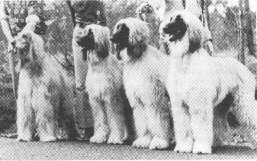 Following an outbreak of rabies in England and the ban on importing dogs from Europe, ultimately I acquired ISMENE VDOM, to complement BADIN. Then when Eta gave up breeding, she offered me her last two stud dogs NT. CH. KOEM VDOM., and Racing Ch. TOPPER VDOM a grandson of an Afghanistan import. Margaret Snelling bought KOEM and I kept TOPPER, who without any doubt, was the most intelligent and clever dog I have ever owned. 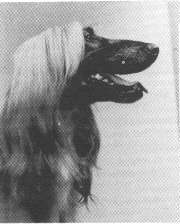 QUESTION: What about your show successes as an exhibitor and a breeder? BARBARA: In England - I won quite a number of B.O.B. awards at Open Shows, and classes at Championships Shows in strong competition. In Australia, my first major success was B.l.G. at the 1956 SYDNEY ROYAL with AGHAI. BEST IN SHOW awards were won by me with GOLITHA YASMIN, TAJ AMIGO OF CHAMAN (UK), and GOLITHA MUSTAPHA - the latter scoring B.l.S. 14 times which was quite an achievement in those days and created a record which lasted many years. From my first 40 champions, 14 scored B.I.S. I suppose themmajor ones would be Royal Show B.l.S. winner ELTAZZI PUSHTU DIN (Badin X Ch Eltazzi Fayida). Similarly, B.I.S. at the 1972 New Zealand National TUX show was 43 times B.l.S winner ELTAZZI TAMA -he was also Runner Up to Best Dog all breeds in N.Z. for 3 years. Tama was a blending of BADIN, TAJ AMIGO OF CHAMAN, AJMAN SHIRAMIN and my early English and Australian lines. Major Afghan Specialty B.I.S. winners have been won by EL TAZZI GENGHIS KHAN who won 11 B.I.S. awards, and multiple Specialty B.I.S. winner ELTAZZI UKOOM. 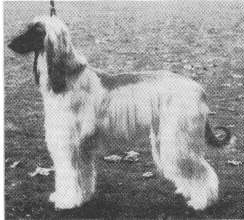 QUESTION: What efforts did you make to educate the Australian public in the early days of Afghans? BARBARA: When it became apparent soon after I arrived, that the judges and general public needed to learn something about the breed, I wrote numerous articles which were published in many K.C. Journals and Dog magazines. I corresponded widely overseas with Afghan fanciers and picked their brains in order to incorporate their knowledge into articles for the Australian dog fraternity. I delved into the history of the breed here and found that Afghan Hounds had accompanied some of the Afghan camel drivers to this country last century. These camel trains travelled around to the isolated early settlements of the Australian Outback, selling essential wares to the pioneer settlers during the 19th and early 20th centuries. I have in my possession, a letter written to me by the first female born on the Kalgoorlie Goldfields, in which she describes a bitch who elected to live in her mother's tent - an almost perfect description of a desert type hound. QUESTION: Who had the first registered Afghans in Australia? BARBARA: Several Afghans prior to W.W.2 were brought to Australia by Olive Macdougall (wife of Jim MacDougall, a prominent Sydney journalist). Unfortunately these lines had died out. Olive was most impressed with AGHAI and was most co-operative in helping with information. She became the first Patroness of the A.H.C. of N.S.W. when it was formed in 1956 - a club I was instrumental in setting up. QUESTION: When did you start judging, and when did you get your All Breeds license? BARBARA: In 1953 in England, then in 1963 in Australia I became an All Breed Judge. QUESTION: So you have been an active Afghan breeder/judge for 37 years- is that a world record? BARBARA: I don't know - there are some judges who have been judging longer than me, but I do not know if they are still active breeder/exhibitors. QUESTION: Which foreign countries have you judged in and which interested you most? BARBARA: On a return trip to England, I judged there, also New Zealand, U.S.A., Germany. The most interesting would have been the big Sighthound Specialty in Bad Homburg in Germany. In Europe, the working qualities have always been emphasised, and Afghans can win the coveted U.l.C.I. championship by acquitting themselves well not only on the showring, but also on the racetrack. In England, possibly due to shows often being held indoors, many seemed to shuffle around the ring, with huge coats, little muscle tone and long weak loins. Balance was better in the USA, but glamour and showmanship appears more important than correct breed type.
QUESTION: What suggestions might you have to improve the abilities of new judges to the breed? ANSWER: A difficult question. I personally feel they should be assessed by at least one breed specialist of long standing, which is seldom the case nowadays. I also feel far more emphasis should be put on the origin and purpose of the breed - why it developed the way it did, and what features particularly fit it for the purpose for which it was originally bred - after al this is BREED TYPE. Again I would like to see racing and preferably coursing (which is closer to hunting in the wild) be part of the aspiring judges' education, so they could see and assess for themselves, how certain features of conformation would help or hinder a dog doing its work. QUESTION: Talking of racing and coursing, how do you think these activities can benefit the breed? BARBARA: I have over the years, had my hounds hunting rabbits, etc., also racing and coursing. The hunting was mostly accidental, when exercising my dogs, it was always possible that they would start a rabbit, hare or squirrel. My first Afghan, BAHBOOK OF BLETCHINGLEY would be Iying apparently asleep on the front porch one minuite, and down the drive after a squirrel the next. On several occasions, she even went up into the lower branches of a big beech tree after them. She was also a great rabbiter, many were the dinners she caught herself. Once when some deer escaped from a local park, I discovered Bakbook, her daughter and granddaughter were missing. On looking for them in the distance I saw them chasing one of the deer on the hill opposite - it was an unforgettabie sight seeing them all in full flight. We had a lot of fun racing our dogs on a local track, thedogs loved it and would get so excited when the car drove into the track entrance. However, when it became highly competitive and so much emphasis was put on first past the post, we stopped racing as the Afghan is not just a speed merchant - he is also the most agile of the sighthounds and the points of conformation which govern speed and those which govern agility are different - so to put too much emphasis on speed and to breed for those points, is to my mind wrong. We then started to lure course - we found many of the dogs which had not been keen racers were far keener to course, it was more natural for them. In coursing, they have to show their agility as well twisting and turning at right angles. When coursing in pairs, they often show their initiative and try to cut off the lure - this is one reason why we did not persevere to follow the American Field Coursing Association format, as their rules do not allow for a hound which shows this true instinct, but marked them down for cutting corners. Finding suitable grounds for coursing makes it hard to continue with this sport - but it is a lot of fun and the dogs love it. It gives them a purpose in life besides keeping them in a fit, hard condition. QUESTION: So your experiences have taken you through from the days when the breed was just 'a hairy Greyhound' to the peaks of popularity in the 70's and down again. Could you relate the virtues and the problems in the Afghans of the early 60's to the 90,s? BARBARA: Looking back, one tends to remember only the good things - the Afghans in the 60's were still true hunting dogs - the top show dogs of the 90's in comparison, are just show dogs with very little left of their hound structure. Emphasis is now on cosmetic features which are often detrimental to breed type. In the early 60's, it was still possible to win with a sound, typical Afghan out of coat - the bitches especially were not heavily penalised for a seasonal coat drop - which they would be nowadays. In the 90's too many lack balance by having straighter front angulation compared to over angulated rear ends - to compensate for this imbalance the muscles develop incorrectly resulting in movement lacking in a smooth effortless ground covering stride. In its place we see short stepping forelegs with hindfeet overreaching. Temperaments were quite different some of the DESERT types being aloof to the point of shyness, whereas some of the MOUNTAIN types showed the certain keen fierceness though they rarely picked a fight and they were always ready to hold their own with the best. Many had a highly developed sense of humour - you learnt to live with them rather than the other way around. You had to respect them because they had a mind of their own. On the whole they were a strong basic hunting dog, and though devoted to 'their' people, were never subservient. With the emphasis on show and glamour, many lack the strength of character because it was too difficult to mould the original character into a consistent show dog. QUESTION: Going back to the constructional changes, can you elaborate? BARBARA: During the popularity peak of the 70's, the 'get-rich-quick' breeders bred from incompatible lines with little regard or study as to the outcome. 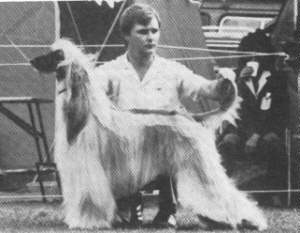 We also started to get more American judges - it was cheaper and easier than bringing them from Europe, many of them put emphasis on glamour and showmanship, they preferred a straighter front because it made the dog look more upstanding, and so on. Later many of the imports helped this trend, and anything that could win was more important than correct construction. Personally, I think it is getting to the point where show dogs should be tested for drugs and checked for cosmetic surgery. After all, we all know mouths, tails, pink third eyelids, and so forth are being fixed, so who is fooling who? QUESTION: And what about handling in the ring? BARBARA: When I first showed Afghans, they virtually showed themselves on a loose lead, check chains were never used. Nowadays they are strung up with a check chain pinching under the ear so that the dog dare not move its head, tails held rigidly high and with overstretched hindquarters, one can't help thinking that if the handler let go, the dog would fall in a crumpled heap. How any dog could look aloof AND dignified presented like this I fail to see. On the move, they are raced around so fast, that once again they lose any dignity they might still possess. QUESTION: What are your views on coat presentation? BARBARA: With the emphasis on more and more coat, presentation now involves a lot of trimming to give shape to the Afghan - despite the fact that the Breed Standard states 'The coat must develop naturally'. It is difficult for judges to assess the amount of trimming when it is done skilfully, which again makes it difficult to penalise when not done skilfully. I certainly recall at one of the first Afghan Specialty shows at which I judged, I put up a trimmed dog, simply because he was the best there, but he still would have won untrimmed! Of course we tidy up saddles and necks but only by hand, and only when the saddle fluff was ready to come out. QUESTION: Your views on these detrimental changes in Australian Afghans are substantiated in critiques by a Scandinavian judge at the '90 Sydney Royal Show and an American judge at the '90 Victorian EXPO. What disappoints you most about present day breeders BARBARA: The lack of dedication to the breed as such - a number of the modern day breeders are too busy following fashion 'in the guise of improving' it to win. Their total lack of respect for the older breeders who carefully and studiously laid the foundations to get the best stock, Afghans which are the basis of the pedigrees on which they breed 'their winners'. We didn't have all the 'aids' they have nowadays, nor the gene pool with which to work. Practically never do new breeders bother to ask older breeders why they did earlier matings, particularly outcrosses - what virtues were they trying to establish or what faults were they trying to remove, and most importantly, were these matings successful. There seems to be an analogy between many present day breeders and the average teenager, he thinks he knows more than his parents. QUESTION: Finally what other hound breeds has ELTAZZI been involved in? BARBARA: Besides Afghans, Borzoi, Pharoah Hounds, Ibizan Hounds and since the 60's Italian Greyhounds - this last breed is the one I am most involved in these days, however the Afghan Hound will always hold a special place in my heart. Copyright(c) 1990 Helen Furber Australian Afghan Hound Yearbook Related Content Mrs. Olive Macdougall (Kandahar) Mrs.V B West (Bara-Khel) Mrs. Barbara Skilton, (El Tazzi), by Steve Tilotson and Lyall Payne July 2015 History Of The Breed Down Under by Helen Furber (Furbari, Aust), 1969 ADD FRED LONG LINK HERE An analysis of the breed by Lynette Watson (nee Schelling), 1970's Jim Hickie article on Australian breed history Fear of Possible Mennace -"The Post's" Sydney, Australia, 1935 An Interview with Barbara Skilton Of Eltazzi Kennels Mr Mrs James Abbott (Khyber Afghan Hounds Australia) by Steve Tilotson September 2019 Whats New Page |
